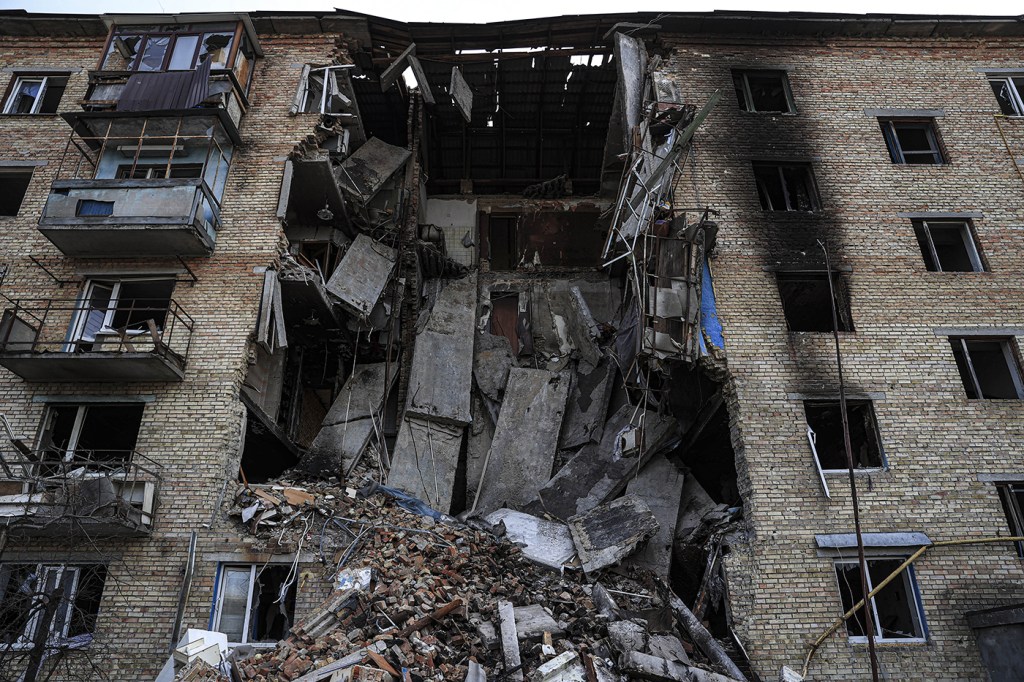War crimes, crimes against humanity, or genocide? How to understand Russian atrocities in Ukraine.

This report is part of ongoing coverage of the Russia-Ukraine war. Visit our dedicated page for more on this topic.
Evidence of Russian potential war crimes in Ukraine has been mounting, as photos and reporting showing mass executions, mass graves, and (in some cases, tortured) bodies of civilians in the Ukrainian city of Bucha circulate online.

Amnesty International on Thursday said that Russian military forces have been carrying out “extrajudicial” killings of civilians following new on-the-ground research from the scenes of executions. Civilian deaths in the war have greatly increased in recent days, with deaths in cities like Mariupol surpassing 5,000, according to the Associated Press. On Friday, a Russian missile strike on a train station in Kramatorsk reportedly killed 50 people, including five children.
News@Northeastern spoke to Alexandra Meise, associate teaching professor of law at Northeastern, about how the international community can proceed in trying Russian leaders, namely Russian President Vladimir Putin, for alleged war crimes. She previously taught international human rights law, and years earlier worked for the court that tried senior Khmer Rouge leaders in Cambodia.
Her comments have been edited for brevity and clarity.
How might the images, photos, and videos we’re seeing coming out of Ukraine be used by an entity, such as the International Criminal Court, in pursuing war crime charges against Putin?
Everyone now has a cellphone, or more than one cellphone, and so we are seeing images in real time, or nearly immediately afterwards. That, combined with the volume of the data, is a scale that we haven’t really seen before.
Ukraine is a country where you had a very high degree of technology use before the conflict. In fact, many of the world’s top technology experts work in Ukraine. So, you have potentially millions of people with the equipment and the know-how who could gather pictures and video of alleged crimes and distribute it. But is it evidence that could be used in a court of law?
We commonly use this phrase “a picture is worth a thousand words”—and it can be. But a picture also has context. And we need the context for the picture. That will include details such as who took it, where it was taken—and I mean a very precise location, like the GPS coordinates—the directionality of the picture (is it facing north, is it facing east?), the time of day, points of reference in the picture that can help confirm size and proportions, etc. You start to get this whole list of information that you need or want.
When we’re thinking of evidence, we also have to ask: What’s the chain of custody? Electronic files can be copied, they can be altered, they can go through many hands before they get to their destination. As much as original files can be preserved in their original format the better, but how does one do that in a dynamic environment that is still an active conflict zone? There are a lot of questions raised in this area.
It also has to be underscored that pictures and videos alone have limits. They may show us what’s in the four corners of a particular frame, but they may not show us the intent or mindset of those in the image or who perpetrated the acts that caused what we see in the image. That’s crucial context too.
International law is binding, but I know there’s some question about how to enforce it. Who can be tried—and what are the challenges in actually prosecuting them?
The ICC has made clear that there isn’t head-of-state immunity. So a head-of-state can be charged, and the Rome Statute also says there’s no statute of limitations for crimes within the court’s jurisdiction.
Evidence can be gathered now, preserved, and we can wait, if that’s what has to happen before a case can proceed. There are certainly circumstances where a warrant has been issued for someone to appear before an international criminal tribunal, and it has taken a very, very long time for that person to actually see their day in court. Sometimes that’s because a person is very good at hiding. Think of some of the folks charged from the former Yugoslavia—they managed to hide for quite a while before being caught. So that’s one of the obstacles in the process; but there are obligations for those who are State Parties to the Statute to act in conformity with the Statute’s text and purpose. If there’s a warrant issued pursuant to ICC processes, parties are supposed to act in accordance with that.
What is the difference between a war crime, a crime against humanity, and genocide?
These are all spelled out clearly in the Rome Statute. War crimes occur during times of armed conflict; crimes against humanity can occur during times of armed conflict, or possibly during times of not armed conflict. Some acts can be a war crime and a crime against humanity, but not all war crimes are crimes against humanity. Crimes against humanity require “widespread or systematic attack(s) directed against any civilian population, with knowledge of the attack.”
So, killing one person, depending on the context, could be a war crime; but with crimes against humanity, you’re looking at something that’s widespread and systematic—in other words, involving multiple civilian victims.
The Genocide Convention compels those who are a party to it to take action to prevent and to punish genocide. This is one of the reasons why the international community is very hesitant to use the word genocide—it comes with a bucket of obligations if we recognize that it happened or is happening.
When trying to show a genocide has occurred, you have to show there’s a specific intent to do it. How do you show that intent … to destroy “in whole, or in part, a national, ethnical, racial, or religious group?” That can be quite complicated to prove in court.
What is your reaction to Russia being booted off the UN Human Rights Council?
This is rarely done. To see the international community come together to do this I think shows the strength of the consensus that what Russia is doing is outside of acceptable international norms.
For media inquiries, please contact media@northeastern.edu.






